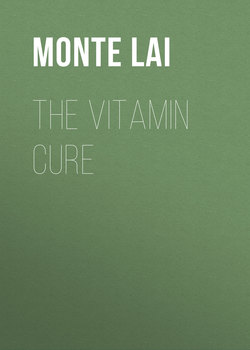Читать книгу The Vitamin Cure - Monte Lai - Страница 12
На сайте Литреса книга снята с продажи.
Оглавление3
VITAMIN B2 (RIBOFLAVIN)
Vitamin B2 is also called riboflavin. Its discovery has a colorful history. In the late 19th century, scientists discovered a bright-yellow fluorescent substance in milk. At that time, no one knew anything about this fluorescent substance. In 1930, Otto Warburg and his associates isolated the same substance in yeasts. They showed that it could repair damaged cells. In later years, Warburg’s group confirmed that the bright-yellow substance was riboflavin. Since it was the second vitamin B discovered, it was called vitamin B2.
Riboflavin by itself has no biological activity. It is involved in the synthesis of two important cofactors, FMN (flavin mononucleotide) and FAD (flavin adenine dinucleotide), which support the activities of many enzymes in the body. These enzymes participate in energy production, drug metabolism, and toxin degradation. FAD is also involved in the antioxidant enzymatic reaction that gets rid of free radicals, preventing them from causing cellular and DNA damage. Glutathione is often thought of as the mother of all antioxidants in the body. Glutathione deficiency is common in many chronic diseases, including Alzheimer’s disease, heart disease, stroke, cancer, and diabetes. FAD boosts glutathione levels and enhances the body’s antioxidant capacity. It is also required as a cofactor for the synthesis of new red blood cells. Riboflavin insufficiency can hamper iron absorption and cause anemia.
What Are the Symptoms of Vitamin B2 Deficiency?
• The major symptoms of vitamin B2 deficiency include throat pain, fatigue, skin inflammation and peeling, swollen and inflamed lips, new blood vessels growing in the corneas, anemia, endocrine malfunction, and neurodegeneration.
What Are the Causes of Vitamin B2 Deficiency?
• Diseases. People with congestive heart disease and alcoholism are at high risk of vitamin B2 deficiency. Conversion of riboflavin to cofactors FMN and FAD is blocked in patients with hypothyroid disease and adrenalin insufficiency.
• Insufficient intake from foods. Milk, eggs, and meat are the major food sources of vitamin B2. Researchers in Poland revealed that among people aged 20–25, about 33.7% of women and 25% of men were vitamin B2 deficient due to insufficient intake of vitamin B2 from foods.
Prevention and Treatment of Diseases
• Prevention. Vitamin B2 may prevent cataracts (49), cardiovascular disease (48), lung cancer (82), breast cancer (47), and colon cancer.
• Treatment. Vitamin B2 may help treat migraines (88), hypertension (78), and corneal disorders.
Which Food Items Are Vitamin B2 Rich?
Milk and dairy products are excellent sources of vitamin B2. Animals’ internal organs (e.g., liver, kidneys, heart) as well as plant-based foods—such as nuts, legumes, and dark-green leafy vegetables—are good sources of vitamin B2. Vitamin B2–fortified foods include bread, spaghetti, and breakfast cereal.
This list of vitamin B2–rich food items is adapted from information provided by the USDA.
| FOOD | PORTION | VITAMIN B2 CONTENT, MG | % DAILY REFERENCE VALUE |
|---|---|---|---|
| Lamb | 3 ounces | 3.90 | 229 |
| Beef liver | 3 ounces | 2.90 | 170 |
| Yogurt | 1 cup | 0.57 | 34 |
| Milk | 1 cup | 0.45 | 26 |
| Almonds | 1 ounce | 0.32 | 19 |
| Eggs | 1 | 0.26 | 15 |
| Mushrooms | ½ cup | 0.23 | 14 |
| Spinach | ½ cup | 0.21 | 12 |
| Chicken | 3 ounces | 0.16 | 9 |
| Beef | 3 ounces | 0.15 | 9 |
Daily reference value of vitamin B2 is 1.7 mg according to the 2013 FDA food-labeling guidelines.
What Are the Recommended Dietary Allowances for Vitamin B2?
| 1–3 years | 0.5 mg |
| 4–8 years | 0.6 mg |
| 9–13 years | 0.9 mg |
| 14–18 years | 1.2 mg (boys); 1.0 mg (girls) |
| 19 years and older | 1.2 mg (men); 1.1 mg (women) |
There is currently no known toxicity of vitamin B2 and no upper intake limit for vitamin B2.
Vitamin B2 Supplements
• Dosage. The most common dosages of vitamin B2 supplements are 50–100 mg, which is much higher than the recommended dietary allowance of 1.2 mg. Nevertheless, vitamin B2 is relatively safe, even when taken at high doses. Various B vitamins seem to act in synchrony and exert complementary effects in the body. If you are a vegetarian and need to take vitamin B2, you may consider taking a vitamin B complex supplement. Vitamin B is bright-yellowish in color, so you should expect your urine to turn bright yellowish when taking a vitamin B2 supplement.
• Hypertension. The MTHFR gene encodes methylenetetrahydrofolate reductase, an enzyme that is critical for folate metabolism, and vitamin B2 is required as its cofactor. Globally, about 10% of people have MTHFR gene polymorphic variants, while 20% of the people in northern China and 32% of all Mexicans carry variants of this gene. Certain MTHFR gene variants cause congenital hypertension, a condition that cannot be controlled by antihypertensive drugs alone. Clinical studies have shown that a combination therapy consisting of antihypertensive drugs and vitamin B2 lowered systolic pressure by 9.2 mmHg and diastolic pressure by 6.0 mmHg in patients with congenital hypertension. The suggested vitamin B2 dose is 1.6 mg daily for 16 months.
• Migraine. Vitamin B2 may mitigate symptoms during a migraine attack. Randomized controlled trials have shown that taking vitamin B2 reduced the incidence of migraine attacks and pain by 50%. In this case, the suggested vitamin B2 dosage is 400 mg daily for three months.
What Types of Drugs May Interact with Vitamin B2?
• Anticonvulsant drugs that prevent seizures and Adriamycin (doxorubicin), used to treat breast cancer, reduce the blood level of vitamin B2.
